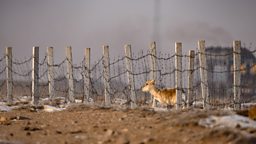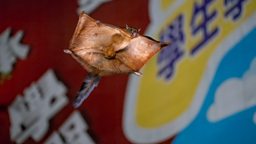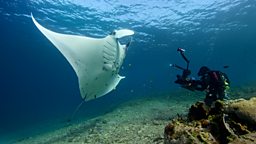Filming proboscis monkeys in Borneo
By Ben Harris, Cinematographer

I’ve always found primates endlessly fascinating to film. Their expressions and behaviours grab my attention in a way few other groups of animals do, and the addition of a large fatty nose makes proboscis monkeys particularly charismatic.
...a large fatty nose makes proboscis monkeys particularly charismatic.
To film them, a small team from the UK were dispatched to a city on the island of Borneo where proboscis monkeys are present. Emma Hatherley (Producer), Sam Rowley (Assistant Producer), Ollie Richards (Cinematographer), and myself had just over three weeks to capture what we needed.
The challenge was to film the resident family of proboscis monkeys swimming back and forth across a river as they dodged boats, fishermen and crocodiles to reach the freshest leaves. To do this we split into two teams: Sam and I were the terrestrial team, using long lens and remote cameras; Emma and Ollie were the boat team, using a large, stabilised camera mounted on top of a boat to cover the action from the water.

The boat was our secret weapon, with its ability to keep up with the monkeys through forests and mangroves. The sequence wouldn’t have been possible without it, but even so, the boat team struggled to get near enough to film big close-ups. Shots of eyes, fur, hands and feet, and (in this case) the nose, are integral parts of a blue-chip natural history sequence. It fell to me to capture these essential shots.
The boat was our secret weapon...
There were two locations where we had an opportunity to get close to the troop: the pipes, and the dock. The pipes were three water pipes that were each as thick as a large tree trunk and formed a bridge that spanned the river. The dock was a huge concrete structure that served as a meeting place for people, and got quite busy in the evenings as folks gathered to buy street food and hang out.
These crowded, busy evenings were representative of one of the key challenges involved in making a film about wildlife in human-made environments: the people. Not only did they make it less likely the monkeys would put in an appearance, we also became minor celebrities for the month we were there.

It must have looked strange indeed for two guys from the UK to be sat on the dock with a big camera for an entire month. Regulars at the dock began to recognise us and ask daily if the monkeys had crossed or we had gotten any shots. The more times we had to say “No, unfortunately not today”, the more intrigue turned to amusement. But our tenacity eventually paid off, as the monkey darted across the bridge between the crowds to reach their evening feeding spot.
he passed close enough for me to finally get my close-up of that impressive, iconic, proboscis.
Further down the river were the pipes. The monkeys occasionally crossed here when the people weren’t around. If it happened, this would provide our best opportunity for close-ups. Unfortunately, the local fishermen used the pipes as a prime fishing spot, dropping their lines into the middle of the fast-flowing river below.
Our best opportunity was to settle in just before it was light enough to film, before the sun came up around 4:00 in the morning. All it needed was a late start from the fishermen one day, and suddenly I was surrounded by the whole troop of proboscis monkeys. A male led the way, staring at me for the full hundred metres it took him to cross the river. As he got close, he bared his teeth, looked back to beckon his family across, and then leapt into the mangrove trees that surrounded the pipes on the shore side. He kept an eye on me as I filmed his family arriving, and as they dispersed into the mangroves, he passed close enough for me to finally get my close-up of that impressive, iconic, proboscis.




































